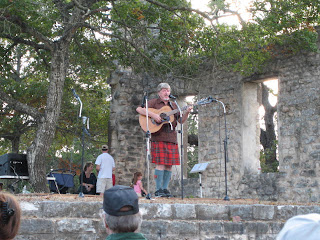Another adventure...

Judy and I went to our first Scottish Gathering & Highland Games event over the weekend. It was in Salado, Texas, just south of Waco.
We arrived on Friday afternoon and took some time to get to know Salado. It didn't take long because it's a small town. We drove through the park and it was so nice that we walked along Salado Creek, a beautiful clear spring-fed creek that flows through town and the park. A fellow Big Green
Egger who lives in Salado suggested we take a look at the park as a possible
Eggfest site in the future. He was right... it would be a great place for an
Eggfest.



But our mission in Salado was to represent our Clan
MacMillan Society of Texas group, so we went to the Gathering site to see where our tent would be placed and get a lay of the land. We were surprised at how large an area the Gathering would occupy.

Saturday morning we found the tent already set up and organized. Mark McMillan and his wife Judy were waiting with plenty of information for those interesting in the
MacMillan family. But after a couple of hours we could tell that it was going to be a slow day.
Judy, Gary McMillan and Mark McMillan

Judy McMillin and Judy McMillan

Mark McMillan and Jane McMillin

Gary McMillan was across the street as a participant in the Highland Games. He was there all day and we didn't learn until Sunday that he came in 3rd in one event. I think I would have enjoyed participating regardless of the end results. Sounds like fun.
Things got a bit exciting though around noon. The wind kept gaining in speed all morning and was now strong enough to destroy our tent. Suddenly, we found ourselves sitting in the open. As people strolled by they would ask where our tent was and we would reply with "We're a poor clan and can't afford a tent" or "Our tent was repossessed" or "Some scoundrel absconded with it while we were visiting the Porta-Let" etc. They figured it out pretty quickly though when they spotted the pile of crumpled canvas and metal.
Just a few of the 100+ tents

The crowd continue to grow and before long there were hundreds of people making their way around the field. Many of them were in traditional Scottish dress proudly wearing their clan tartans. Only two from our little group dressed for the occasion, Mark McMillan and David McMullen.
Mark McMillan

David McMullen

Even so, as small a group as we were, we marched in the parade of tartans which also included a number of pipe and drum corps. We all ended up on the parade grounds where one lonely bagpipe began playing Amazing Grace. It sounded great, but at the end of the first stanza the rest of the pipes and drums kicked in and it sounded absolutely wonderful.
All of the Pipe & Drum Corps on the field

Pipes 'a playing and Drums 'a thumping

The Clan MacMillan contigent in the March of Tartans

Pipe & Drum Major

Judy and I had already made plans to attend the Ceilida (pronounced Kay-Lee) so we left the tent to others to man.
We met at the ruins of ancient Salado College where the Ceilida took place. We learned that since people in the old days had to create their own entertainment they would gather for a Ceilida and each person would entertain the group by whatever means they could. Whether it be playing a musical instrument, or singing a song, dancing a jig, or telling a story, or reading a poem, everyone contributed to the entertainment of the others. Pretty neat concept when you think about it.
Crumbling fireplace at Salado College

Old wall and a really nice backdrop to performances



The setting was perfect for such an event. Very laid back and informal. It was great.
By the end of the
Ceilida we were ready for dinner and decided on The Stagecoach Inn. We knew it had some history behind it but we didn't realize how much until we sat at our table. The Inn began serving customers in 1861. According to the information we read almost anyone who figured
prominently in Texas history either dined there, slept there or hid out there. Yes, even some outlaws spent some time there.
Judy on the porch at Stagecoach Inn


We were tired and were asleep at our hotel by 8:00 PM.
Sunday we were up early to help man our little spot of grass among all the tents, but much to our surprise Gary McMillan drove up with a new tent. The store was good enough to replace the destroyed one. This one worked well, especially after some reinforcing.
We had a few MacMillan's (various spellings) drop by throughout the day. It was fun talking to them. After all, they are "cousins." We also showed them our growing collection of charts, maps and data reflecting the MacMillan history.
According to Mark, there is some information that a MacMillan was a member of the Knights Templar. We had a knight's helmet for those who wished to try it on. I did and it's not very comfortable at all.

We hung around until just after noon and left to return to Houston. I can't see well at night so we didn't want to take a chance that it would get dark on us while driving home.
All in all, we had a good time, listened to some great pipe and drum bands and met a lot of very nice people.
Yes, it was another great adventure.
























